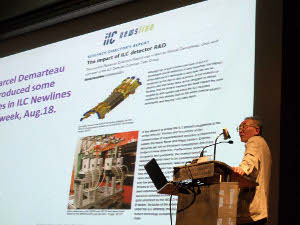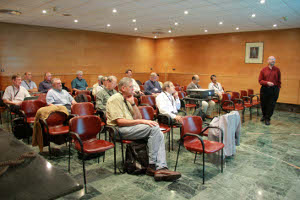In Granada, Spain from 26-30 September, LCWS11 was held jointly between ILC and CLIC for the second time following the Geneva workshop last year. Regarding ILC physics and detector activity, good progress was made and a number of steps were taken for the completion of the detailed baseline design report (DBD). There were many meetings of different types. I wish to introduce some of them, which required cooperation with the wide community beyond the detector groups.
First, there was much discussion about the possible physics cases based on the updated knowledge of LHC result, which narrowed down the allowed mass band of the Standard Model Higgs boson. Theorists may have become more confident about their global analysis in the frame of the Standard Model, which is consistent with this observation. It was stressed repeatedly in different ways how important the particle is. For instance, in his concluding talk for the future prospect of high-energy physics, ILC Steering Committee Chair Jon Bagger said: “It is not a quark, not a lepton or a gauge boson. It is a fundamental spin-zero boson that fills the universe, and was last seen in the very early universe.” When a Higgs-like candidate is found at the LHC, we have to study it precisely to examine whether it is really the Higgs particle. Its firm confirmation will be a historical event in particle physics, and a linear collider will be an ideal facility for that. If, on the contrary, the Standard Model Higgs is excluded, “it will also be a big discovery”, as was emphasised by CERN Director General Rolf Heuer. That will disclose, after many years of experimental effort, the clear deviation from the prediction of the Standard Model. It is an extremely challenging new problem. A whole bunch of theoretical works must be revisited and new ones will be proposed. Also very precise new data will be required to find what can cause the contradiction. It is expected that the LHC will make it clear by end 2012 which case is real.
There was a panel discussion on the first day to discuss such physics prospects, and many views and opinions were exchanged among participants. It was organised by Michael Peskin, the convener of the Physics Common Task Group, who also convenes a group to prepare for the physics volume of the DBD, to present the activity of the group and invite more to join. This was the first open meeting of the group, and the group will continue to study the consequence of the LHC result as it improves.
Second, the International Detector Advisory Group (IDAG) interviewed the two detector groups following their previous meeting several months earlier at the workshop of Americas Linear Collider Physics Group (ALCPG11) in Eugene, US, to hear their status and planning for the DBD. IDAG acknowledged their more refined planning. Apparently this interview helped the groups examine themselves their schedule and strategy for the DBD.
We wished IDAG to give us further advice on the preparation of the DBD. Since it will meet two more times before the completion of the DBD (during the Asian Committee for Future Accelerators linear collider workshop in Korea next spring and LCWS12 in Arlington, US in October 2012), we set a concrete schedule on how IDAG can monitor progress. Each detector group will provide an outline of its DBD by the end of February 2012 and the first draft of the DBD by September 2012. This plan allows IDAG to study the materials and to meet each group with concrete suggestions.
IDAG also heard a report by Marcel Demarteau, the convener of the detector R&D Common Task Group, about the group’s investigation of ILC detector R&D spin-off cases. This attempt was recommended by IDAG last year during its interview, and the group paid much effort for the investigation. A detailed report document, which is nearly finalised, will be made public soon online.
Third, the workshop was timely for the two groups to talk with CLIC colleagues, who completed their Conceptual Design Report recently, about the themes where cooperation can be enhanced. I am informed from both groups that fruitful discussions were made in particular about the collaboration for 1 TeV benchmark simulations.
Last but not least, we concluded together with the accelerator community about which beam parameters are to be used for the benchmark simulations at 1 TeV. The joint plenary session for this purpose was successful. The SB2009 working group, which further worked on this matter, had made necessary studies to prepare for this session. During the session a new idea of the bunch shape was introduced, which will reduce the angular spread of the background. A consensus was reached. We hope event generation will be started soon, after some technical checks, using a parameter set based on this one. By this progress and with the enhanced cooperation with CLIC researchers, the simulation for 1 TeV benchmarks will soon be in full swing.




Recent Comments